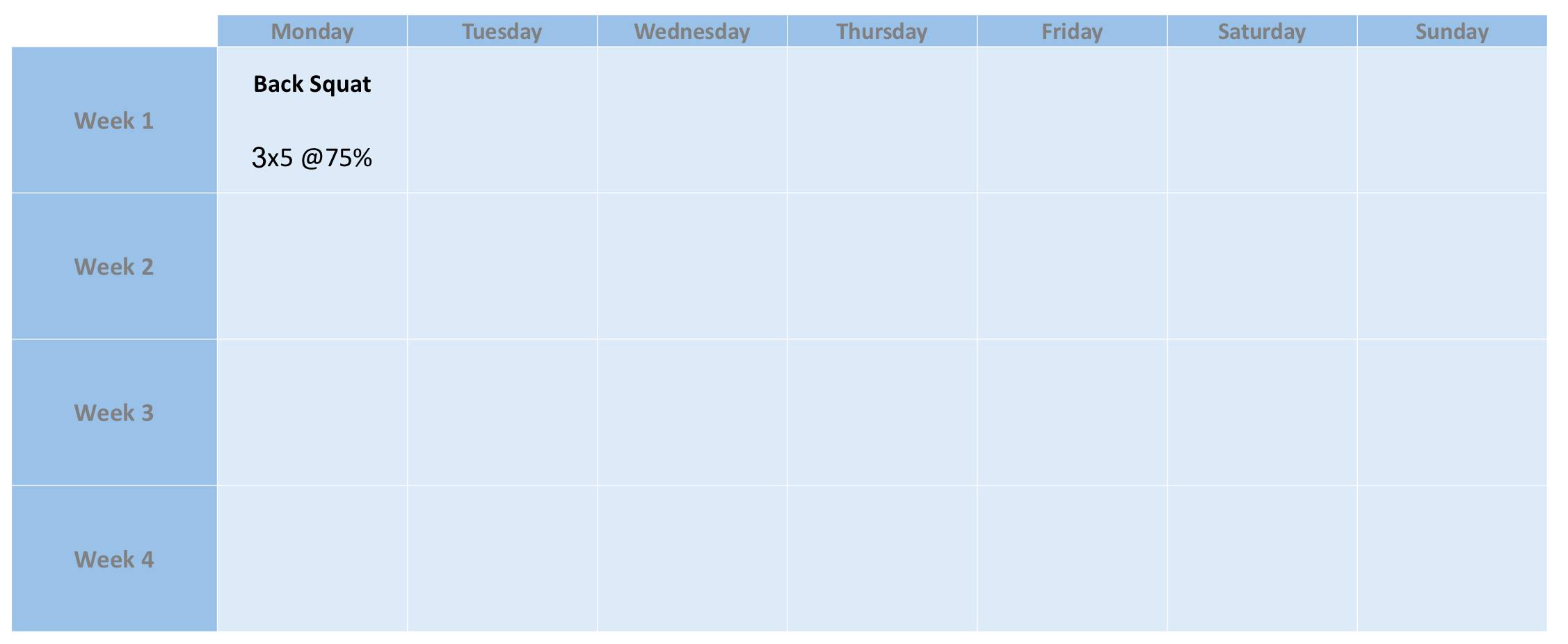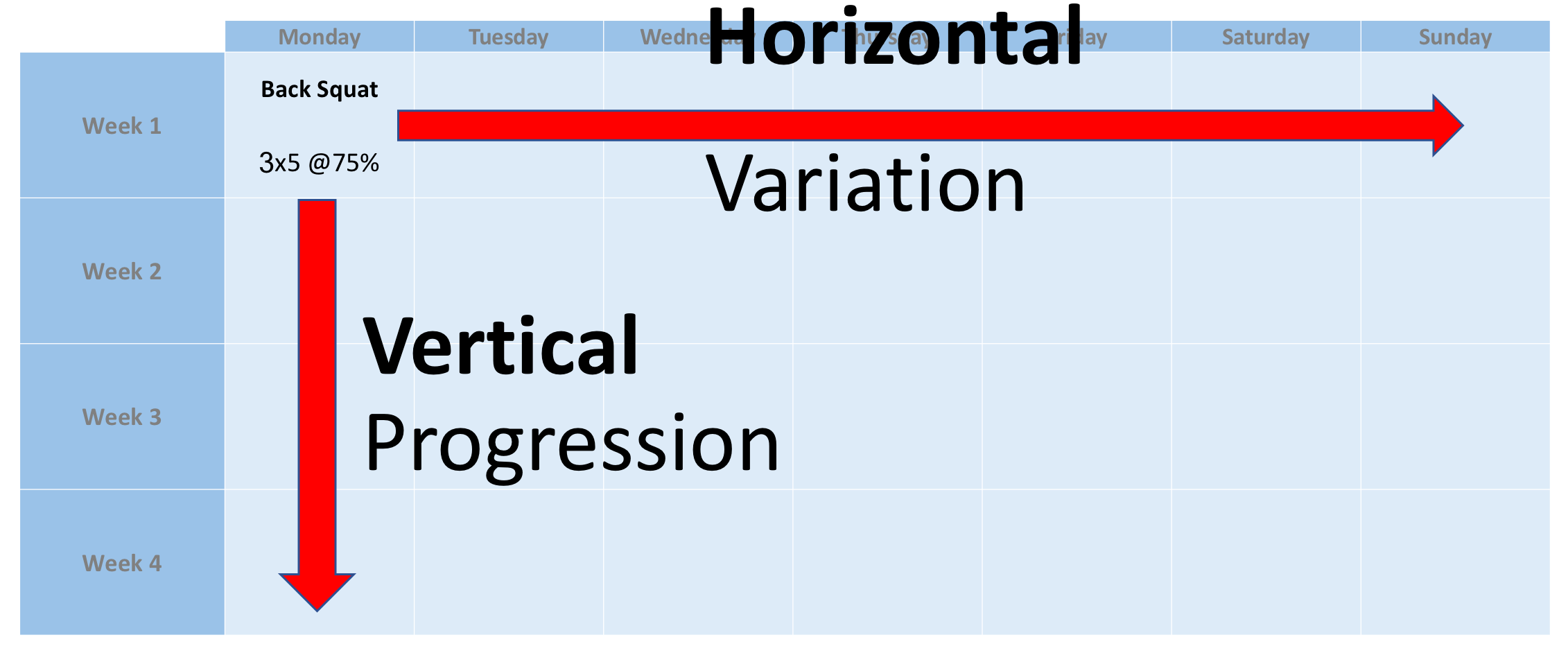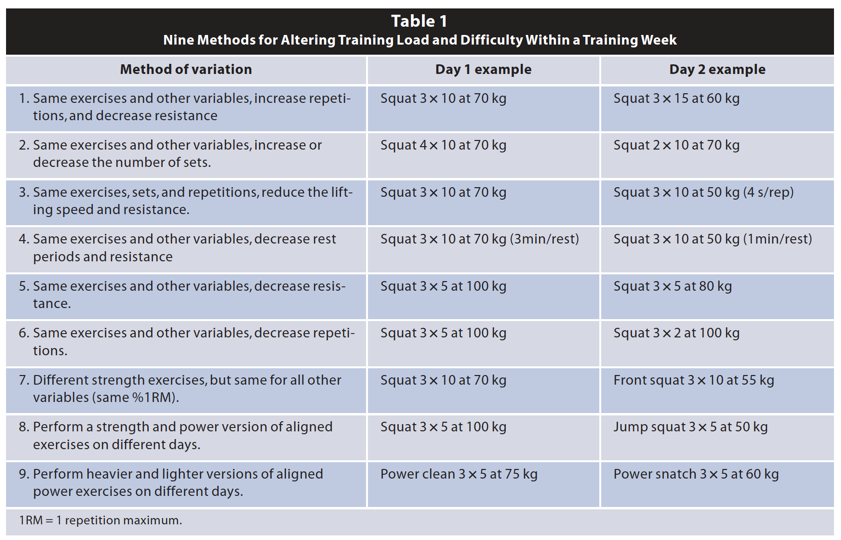Strength Training: Planning The Training Block – Part 3
The following article is going to be part of my upcoming book. This is a sequel to my previous articles Strength Training: Planning the Training Block Part 1 and Strength Training: Planning the Training Block Part 2.
In this part, I will focus on several topics, among which Horizontal vs vertical planning is one of the most interesting, It is a simple framework that is very helpful in planning and designing workouts.
Another topic that I will explore in more detail is indivisible approach. This approach is similar to DUP (Daily Undulating Periodization/Programming), but it is a much more powerful framework for inducing variety and preventing boredom in training.
Horizontal vs. Vertical Planning
Imagine that we have one strength workout on Monday, where we perform Back Squats for 3 x 5 @75%.

Figure 28. Single workout
If we repeat the same movement pattern (squatting) later in the week (say of Wednesday and Friday, or Thursday), we need to figure out which variation to use. When we repeat the same workout next Monday, we need to figure out which progression to make. These two components are referred to as horizontal and vertical planning:

Figure 29. Horizontal planning (variation) and Vertical planning (progression)
Horizontal planning
Horizontal planning, or variation, represents changing a similar workout within the same progression stage. Dan Baker provided an example table of variations that could be utilized when two similar workouts are performed in one cycle.

Figure 30. Baker, D. Cycle-length variants in periodized strength/power training. Strength and Conditioning Journal, 29(4)10-17. 2007.
Similar to categorizations of set and rep schemes, each of these workouts can utilize different objective, prescriptiveness, repeatability and volume. Let’s assume that we are performing squatting pattern three times per week, on Monday, Wednesday and Friday and we aim to hit Hypertrophy (Armor Building), Max Strength (Anaconda Strength) and Power (Arrow), utilizing the following variations of set and rep schemes:

Figure 31. Variations of set and rep schemes for three different objectives
The first option would be the variations of set and rep schemes from the same bucket (objective):

Figure 32. Daily Undulating Programming
Since these variations (horizontal planning) “hit” the same objective (in this case Max Strength), this horizontal planning strategy is usually called Daily Undulating Programming.
In the next scenario, we might opt for hitting different buckets (objectives) on each training:

Figure 33. Daily Undulating Periodization
In this case, we are aiming at a different objective, hence the name for this horizontal planning strategy is Daily Undulating Periodization. The coaches and authors usually don’t make a distinction between these two types of Daily Undulating programs, but it is important to realize that there is a big difference.
Now imagine that, rather than repeating the back squat, we use different variation of the movement (either an exercise that is specific to the squat if you are a powerlifter, or exercise that is within same movement pattern if you are a non-strength athlete):

Figure 34. Same movement pattern – different exercises
In the next example, rather than using different exercises, different objectives, we might opt for hard/medium/easy, or intensive/extensive variants:

Figure 35. Medium-Easy-Hard
If you remember from the saturated-distributed load distribution part of this chapter, I have stated that the more advanced the athlete is, the more saturation might be needed. So, the above example of Medium-Easy-Hard represents one aspect of such an approach aimed at intermediate lifters. In my opinion, the general rule of thumb is that beginners don’t necessarily need any horizontal planning variations (or saturation), whereas intermediates need some horizontal variations (and saturations) and advanced ones need vertical variations (and saturation). More about this will be covered further in the text.
The point of the above examples is that horizontal planning can utilize different categories from set and rep categorizations:

Figure 36. Classification of set and rep schemes, as well as horizontal planning
So, this provides a very flexible framework that you can use to analyze different training programs and when programming yourself.
There is one important quadrant worth mentioning – depending on whether you vary exercises and/or set and rep schemes in horizontal planning, we might have the following scenario:











Responses